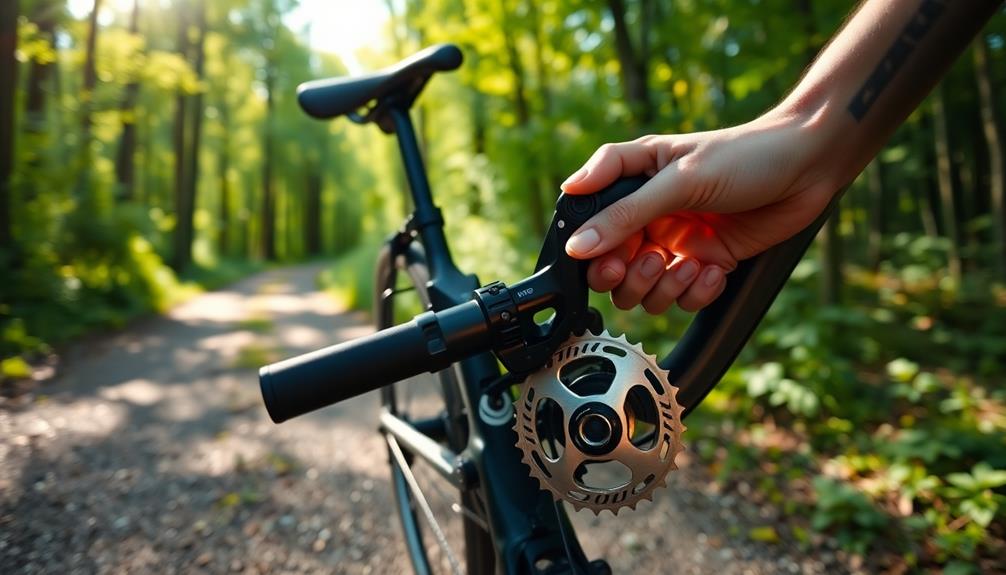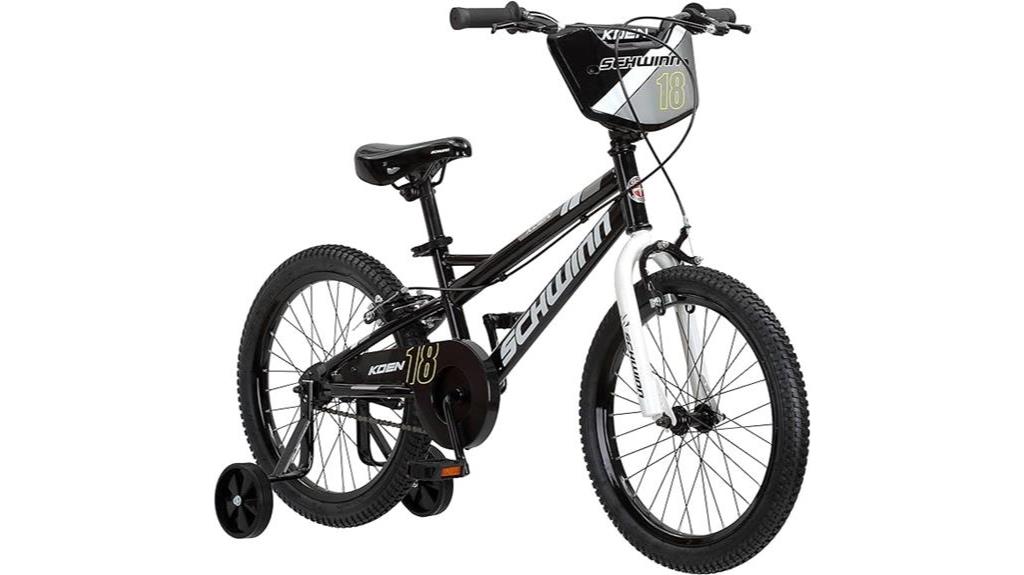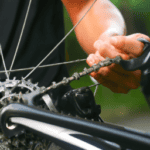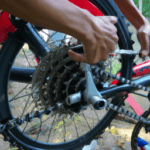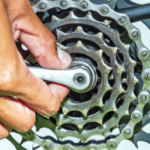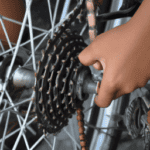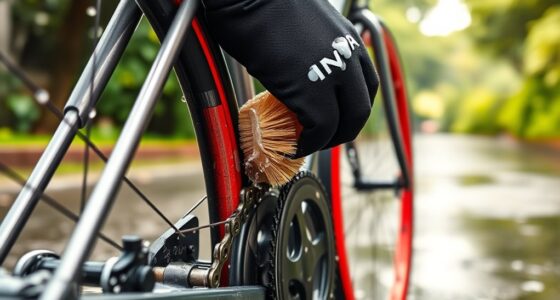Adjusting the gears on your hybrid bike guarantees smooth shifting, which enhances your ride. Start by checking the derailleur alignment and using a barrel adjuster to fine-tune cable tension. Shift through the gears to test performance, adjusting limit screws to prevent overshifting. Regularly inspect your cables for any wear and clean your chain to maintain efficiency. Remember to ease off the pedals when shifting to reduce strain. With basic tools and a little time, you can keep your bike in top shape. There's plenty more to discover to help you refine your shifting technique!
Key Takeaways
- Regularly inspect and clean derailleur components to ensure efficient shifting performance and prevent issues like skipping gears.
- Use the barrel adjuster to fine-tune cable tension for smoother and more precise gear changes.
- Adjust limit screws to prevent the chain from dropping off the chainrings, ensuring reliable shifting.
- Maintain and lubricate cables and housing to reduce friction and prolong the lifespan of shifting components.
- Anticipate terrain changes and practice easing off pedal pressure during shifts for improved riding experience.
Importance of Proper Gear Adjustment
When it comes to riding a hybrid bike, proper gear adjustment matters more than you might think. It's vital for guaranteeing smooth and precise shifting, which ultimately enhances your overall riding efficiency and comfort.
When derailleurs are misaligned, you might experience issues like skipping gears or difficulty shifting, which can be frustrating and even unsafe. Regular gear adjustments can prevent these problems, allowing for a seamless ride.
Additionally, maintaining a clean bike and its components, much like the benefits of healthier living environments, can lead to improved performance and longevity of your gear system.
One important aspect of gear adjustment is checking your gear cables. Over time, they can stretch, negatively affecting your shifting performance and responsiveness. By keeping an eye on them, you can maintain peak functionality.
A well-indexed drivetrain is key, too. Proper adjustment of limit screws and the B-gap guarantees your chain moves accurately between gears without rubbing or dropping, making for a smoother experience.
Lastly, don't overlook periodic maintenance. Lubricating and cleaning the drivetrain keeps components in good shape, prolonging their life and enhancing shifting performance.
Understanding Gear Types
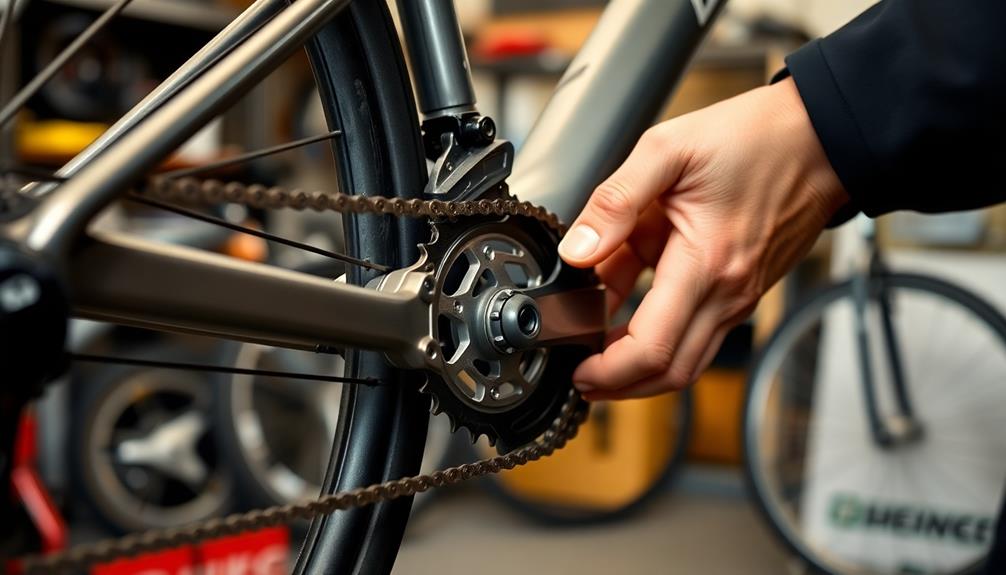
Understanding the different gear types on hybrid bikes is essential for enhancing your riding experience. Hybrid bikes typically feature either derailleur systems or internal hub gears. Each has its benefits depending on how you ride.
Here's a quick comparison:
| Gear Type | Advantages |
|---|---|
| Derailleurs | Wide gear range; ideal for varied terrain; multiple chainrings for climbing or speed. |
| Internal Hub Gears | Simple operation; protection from elements; can shift while stationary; great for urban commuting. |
Most hybrid bikes boast between 7 to 27 gears, with 21-speed setups being popular for their versatility. If you prioritize ease of maintenance and prefer a straightforward ride, internal hub gears might be your best bet. On the other hand, if you seek the ability to tackle diverse conditions, you'll likely benefit from a derailleur system, allowing you to adjust your gear ratios effectively.
Understanding these gear types helps you select the right hybrid bike for your riding style, ensuring you get the most out of every ride.
Gear Ratios Explained
Gear ratios play an essential role in how your hybrid bike performs across different terrains. These ratios are determined by the sizes of the chainring in the front and the rear cogs, affecting how easy or hard it's to pedal.
Lower gear ratios, involving smaller chainrings and larger rear cogs, are perfect for climbing steep hills, allowing you to pedal with less resistance. On the other hand, higher gear ratios, which utilize larger chainrings and smaller rear cogs, enable you to reach faster speeds on flat surfaces, making them ideal for quick rides or racing.
Understanding your bike's gear ratios is particularly important, especially when considering the efficiency of electric power generation with bike generators, which can convert your pedaling into renewable energy for charging devices bike generators.
Most hybrid bikes come with a range of 7 to 27 gears, offering versatility that caters to various terrains and riding styles. By understanding gear ratios, you can select the appropriate gear for your riding needs, optimizing your performance and comfort during different cycling conditions.
Your derailleurs play a significant role in shifting between these gears smoothly, ensuring you can adapt to changing terrains without losing momentum. So, familiarize yourself with your bike's gear ratios, and you'll find it easier to tackle different rides with confidence.
Tools Needed for Adjustment
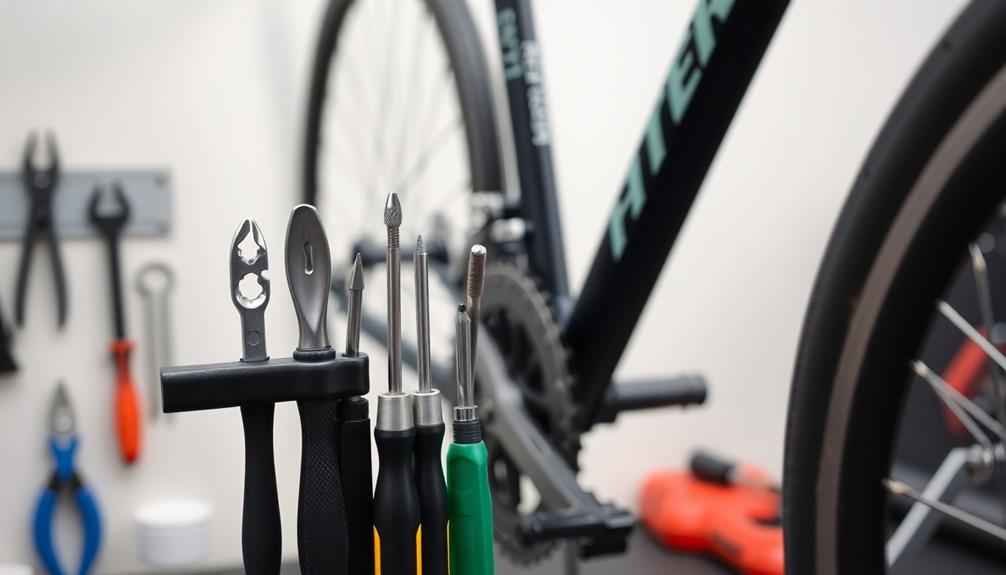
Adjusting the gears on your hybrid bike requires a few essential tools to guarantee the process goes smoothly. First, you'll need a hex key, typically 4mm or 5mm, to secure the derailleur cable retention bolt. This will help make certain that everything stays in place during your adjustments.
A torque wrench can be useful for precise tightening if necessary, giving you confidence that your setup is solid. Additionally, having the right tools can make a significant difference in your overall biking experience, similar to how best vacuums for dust removal can enhance your home environment.
Next, a barrel adjuster is vital for fine-tuning cable tension as you work through the indexing process. This tool allows you to make small adjustments without having to remove the cable, which can save you time.
Don't forget to have some lubricant on hand; it's important for maintaining the cable and housing, making certain smooth shifting performance.
Additionally, keep basic bike repair tools like screwdrivers and pliers nearby. They'll come in handy for general maintenance and any adjustments you may need to make.
Steps to Adjust Rear Derailleur
With the right tools in hand, you can confidently adjust your rear derailleur for ideal performance. Start by shifting to the smallest rear cog and manually checking the alignment of the rear derailleur. Make sure it's straight and properly positioned over the cassette, as proper alignment is essential for effective gear shifting.
Additionally, be mindful of changing gears smoothly to maintain cadence and momentum. Next, use the barrel adjuster to set the initial cable tension; turning it clockwise increases tension and counterclockwise decreases it, which facilitates smoother shifts.
Once you've adjusted the cable tension, release and re-tighten the cable retention bolt to secure the new tension setting. Now it's time to test your shifting performance. Shift through the cogs one by one, making minor adjustments to the barrel adjuster as needed to guarantee smooth changes between gears without skipping or hesitation.
Lastly, don't forget to regularly inspect and clean the derailleur components. Check for wear in cables and housing to maintain peak shifting performance. Keeping everything clean and in good condition will help your rear derailleur work efficiently, allowing you to shift gears seamlessly on your rides.
Steps to Adjust Front Derailleur

To guarantee smooth shifting with your front derailleur, start by shifting to the smallest chainring while setting the rear to the middle cog. This guarantees that the tension is ideal, similar to how proper cable routing is essential for Home Security Systems to function effectively.
Next, slacken the cable tension using the barrel adjuster. Then, re-tighten it to guarantee proper cable routing.
Now, check the alignment of the front derailleur. It should be parallel to the chainrings, with a gap of about 1-3mm between the chain and the derailleur guide plates. You might need to adjust the height if necessary.
Here are some additional tips:
- Fine-tune the limit screws to prevent overshifting.
- Adjust the low limit screw to keep the chain from dropping off the smallest chainring.
- Use the high limit screw to avoid shifting onto the largest chainring.
- Regularly inspect the derailleur alignment and cable condition.
Setting Derailleur Limit Screws
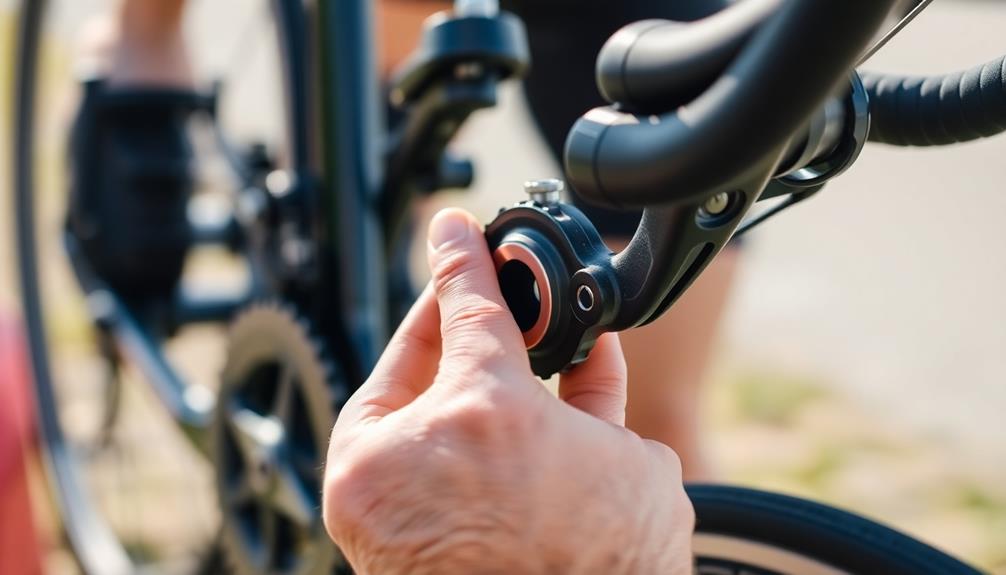
Setting the derailleur limit screws is essential for your bike's performance and safety. These screws control how far the derailleur moves, preventing the chain from slipping off the gears.
Properly adjusted limit screws contribute to the overall efficiency of your bike, enhancing your riding experience whether you're commuting or enjoying a leisurely ride on varied terrains, such as roads or light trails, as highlighted in various terrains.
Importance of Limit Screws
Limit screws play a critical role in the performance of your bike's derailleur by controlling its range of motion. When properly set, these limit screws guarantee that your derailleur can only move within a safe range, preventing the chain from slipping off the cassette or chainrings.
This is essential for maintaining smooth and reliable shifting, especially when maneuvering your rear gears. Just as color accuracy impacts overall image quality, limit screws guarantee the precision of your bike's shifting mechanism.
Here are some key reasons why limit screws are important:
- Safety: Properly adjusted limit screws prevent dangerous chain derailments that can lead to accidents.
- Reliability: They guarantee your derailleur can't move beyond the smallest or largest cog, providing consistent performance.
- Component Protection: Correctly set limit screws protect your bike's components from unnecessary wear and tear.
- Optimal Performance: Regularly inspecting and adjusting limit screws keeps your shifting smooth and prolongs the life of your drivetrain.
Adjusting Limit Screw Settings
Properly adjusting the limit screws on your derailleur guarantees your bike shifts smoothly and safely. These screws control the derailleur's range of movement, preventing the chain from dropping off the cassette or chainrings. Here's how to get it right:
| Step | Action | Result |
|---|---|---|
| 1. Shift to largest cog | Adjust the high limit screw until the derailleur just clears the cog without rubbing. | Prevents chain derailment on high gears |
| 2. Shift to smallest cog | Adjust the low limit screw to make sure the derailleur doesn't push the chain off the smallest chainring. | Keeps the chain secure on low gears |
| 3. Test shifting | Shift through gears to confirm smooth changes. | Guarantees peak shifting performance |
Regularly checking and adjusting your limit screws as part of your maintenance routine is essential. Properly set limit screws not only enhance shifting performance but also contribute to a safer riding experience. By following these steps, you can avoid costly repairs and enjoy a smoother ride.
Diagnosing Common Shifting Issues
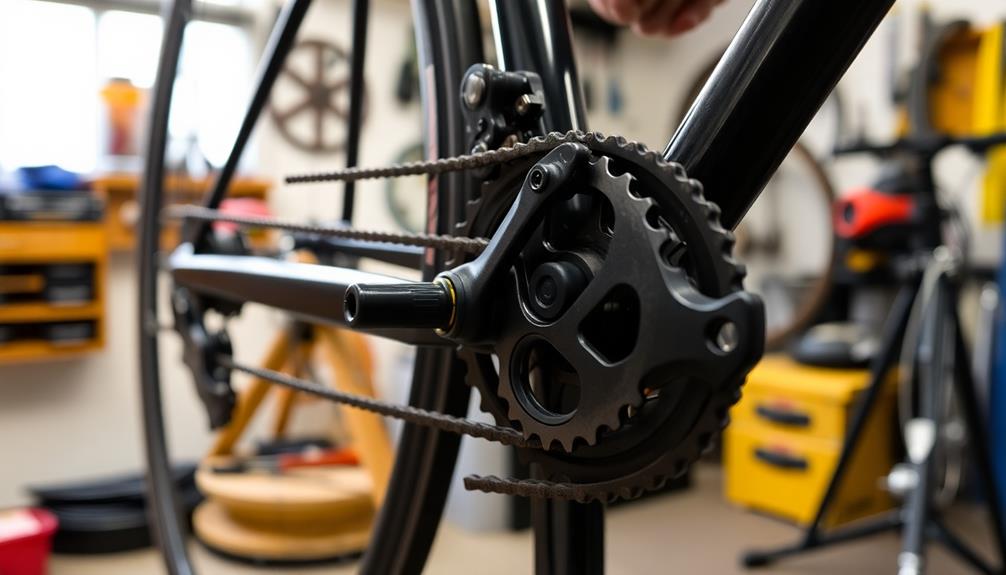
Many riders encounter shifting issues that can disrupt their cycling experience. Diagnosing these problems early can save you from frustrating rides and costly repairs. Here are some common shifting issues and their potential causes:
- Stretched cables: These can lead to inaccurate gear changes, requiring you to re-index the system. The importance of regular maintenance also applies to bike gears, similar to how effective heating requires regular inspection of wood-burning stoves.
- Dropping chain: If your chain slips off the cassette or chainrings, it usually means your limit screws need adjustment.
- Bent derailleur hanger: This can cause improper chain movement, so inspect and straighten or replace it if necessary.
- Dirty cables: Slow or sticky shifting might suggest that your cables need cleaning or replacing along with their housing.
Regularly inspecting your drivetrain with a chain checker can also help identify wear that necessitates replacement, preventing slipping or jumping of gears.
Effective Shifting Techniques
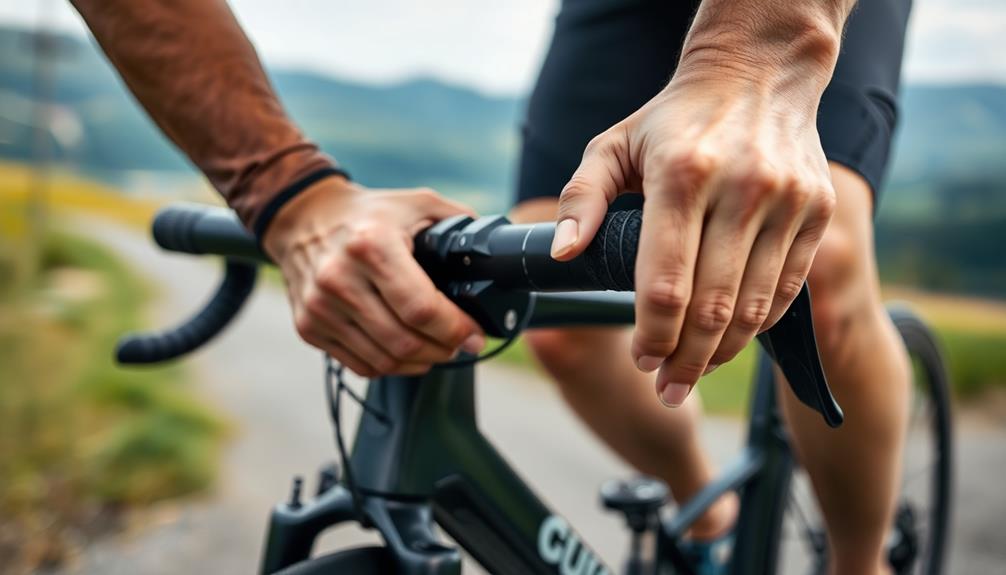
To shift effectively, you need to anticipate changes in terrain, like hills or obstacles, and adjust your gears accordingly.
Understanding your bike's setup, such as the differences between gravel and hybrid bikes, can also help in making smoother adjustments.
Practicing smooth adjustments by easing off the pedal pressure during shifts helps prevent strain on your bike's drivetrain.
By mastering these techniques, you'll maintain momentum and improve your overall riding experience.
For additional insights, consider exploring gravel bike features.
Anticipate Terrain Changes
Anticipating terrain changes is key to mastering effective shifting techniques on your hybrid bike. By doing so, you can shift gears proactively, ensuring a steady cadence and avoiding momentum loss when faced with hills or obstacles.
Understanding how energy-efficient models can impact your ride can also help you make informed decisions about your bike's performance. Here are some tips to help you out:
- Shift to a lower gear before steep inclines to ease climbing and reduce leg strain.
- Downshift in advance as you approach corners or sudden terrain changes to maintain control and prevent pedal strikes.
- Develop an instinct for shifting by practicing anticipation, which helps you avoid late shifts that can slow you down.
- Aim for a consistent cadence of 60-90 RPM by shifting at the right moments, enhancing your ride across varied terrains.
Practice Smooth Transitions
Smooth changes between gears are essential for maintaining momentum and control on your hybrid bike. To master shifting, you need to practice effective shifts. Start by anticipating terrain changes. Shift to a lower gear before approaching inclines to maintain a steady cadence and reduce strain on the drivetrain.
When you're ready to shift, gradually ease off pedal pressure. This technique helps facilitate smoother shifts, minimizing the risk of chain slippage or misalignment.
It's also important to practice shifting on flat surfaces first. This allows you to develop a sense of timing and responsiveness before tackling more challenging terrains like hills or corners.
Make sure you use the right hand for rear derailleur shifts and the left hand for front shifts. Knowing the specific function of each shifter will lead to effective gear changes.
Regularly shifting through your gears during rides is also key. Familiarize yourself with how each gear feels, enhancing your ability to make quick, instinctive adjustments when needed.
With consistent practice, you'll find your shifts become smoother, contributing to a more enjoyable and efficient ride.
Maintenance Tips for Smooth Shifting
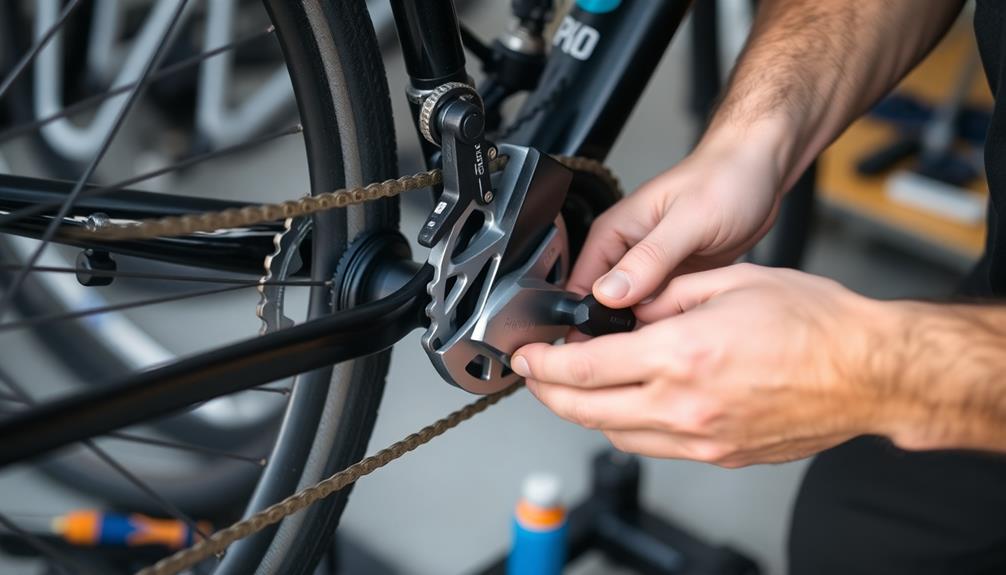
Maintaining your hybrid bike's gears is essential for achieving effortless shifting while you ride. Regular upkeep can make a significant difference in your cycling experience. Here are some key maintenance tips to keep in mind:
- Clean the chain: Use a degreaser and brush to remove dirt and grime that can hinder smooth shifting performance.
- Inspect gear cables: Regularly check for any frayed or damaged cables, as they can affect shifting efficiency and accuracy.
- Adjust derailleur: Verify the derailleur is aligned correctly. Make adjustments as needed to prevent chain skips and guarantee precise gear changes.
- Lubricate periodically: Apply lubricant to the chain and moving parts to reduce friction and facilitate seamless gear changes.
Additionally, perform routine maintenance checks, like monitoring tire pressure and making derailleur adjustments.
By staying proactive with these tasks, you'll enhance your bike's overall performance and shifting reliability.
Frequently Asked Questions
How Do I Make My Bike Gears Shift Smoothly?
To make your bike gears shift smoothly, regularly clean and lubricate the chain, check derailleur alignment, adjust cable tension, shift while pedaling, and anticipate terrain changes to maintain a steady cadence and enhance your ride.
How to Shift Gears on a Hybrid Bike?
Shifting gears on a hybrid bike's like dancing on clouds! You should shift while pedaling, use your right hand for the rear derailleur, and anticipate changes to keep your ride smooth and enjoyable. Enjoy the journey!
Why Is My Bike Gear Shifting Not Smooth?
If your bike's gear shifting isn't smooth, you might have stretched cables, misaligned derailleurs, dirty components, or worn parts. Regular maintenance and adjustments can help restore smooth shifts and enhance your riding experience.
Why Are My Bike Front Gears Not Shifting Smoothly?
If your bike front gears aren't shifting smoothly, check for derailleur misalignment, insufficient cable tension, or worn cables. Cleaning debris and adjusting limit screws can also help guarantee your gears function properly and efficiently.
Conclusion
By taking the time to properly adjust your hybrid bike's gears, you'll guarantee a smoother ride, just like a well-oiled machine from the golden age of cycling. Remember, regular maintenance and fine-tuning can prevent pesky shifting issues down the road. So, grab your tools, follow the steps outlined, and enjoy the freedom of effortless pedaling. You'll be cruising with the wind at your back in no time, feeling like a modern-day cycling knight on your trusty steed!
